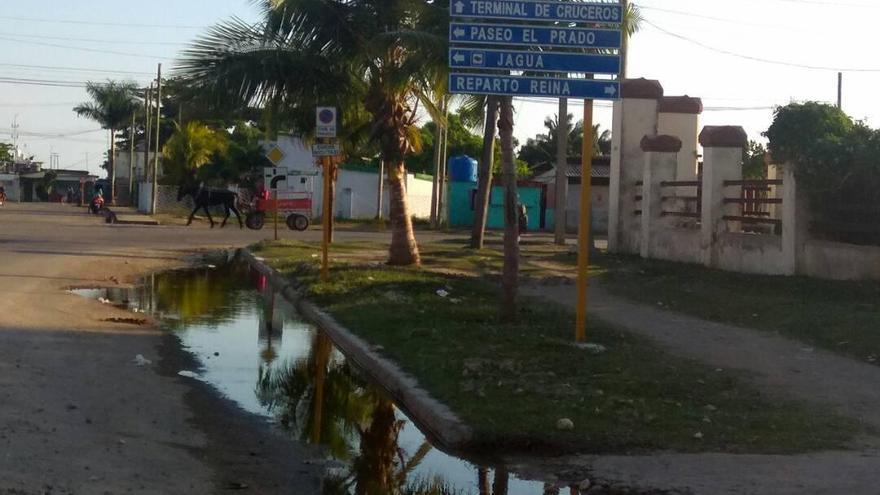
![]() 14ymedio, Justo Mora, Cienfuegos, 23 March 2018 — When Fidel Castro handed over the presidency to his brother in 2006, the sewer leak was already there. Wide, overflowing, smelly and capricious, the largest sewer in the San Lázaro district in the city of Cienfuegos continues to leak, unchanging.
14ymedio, Justo Mora, Cienfuegos, 23 March 2018 — When Fidel Castro handed over the presidency to his brother in 2006, the sewer leak was already there. Wide, overflowing, smelly and capricious, the largest sewer in the San Lázaro district in the city of Cienfuegos continues to leak, unchanging.
Every day dozens of residents at the intersection of 49th Street and 66th Avenue are forced to jump to avoid sewage flooding over their shoes.
“That leak is historic, if it could talk it would narrate the struggles of our people to achieve their independence,” jokes Cristian Betancourt repeating a fragment of a well-known monologue.
Betancourt, 21, says he does not remember the street without its sewer leak. “When I was a kid we made paper boats to sail there,” he recalls.
The main concern of the residents of the neighborhood of the neighborhood is the fecal matter that escapes through the drain.
“We have complained to all levels of government and we have not received a response,” said Orael Sánchez, a resident of the area.
The repair and maintenance of the hydraulic networks is the job of the employees of the Aqueducts and Sewer Business Group, who apply “temporary solutions” to the leaks.
“The Aqueducts and Sewer Business Group employees come and close the water pipes to stop the leaks, and sometimes they have blocked a hole but it just breaks through on the other side,” explains Sánchez. The lack of repairs and maintenance of a hydraulic network that dates back to the first years of the Republic, early in the past century, has made leaks in the city’s system a common occurrence.
In 2016, one of the pipes that supply water to the city collapsed twice, generating a small sea in Calzada de Dolores, one of Cienfuegos’ main arteries.
Reports from the local press details more than 400 complaints from neighbors about the persistent leaks. The establishment of “rapid response brigades” within the Aqueducts and Sewers Business Group has not delivered results, the neighbors say.
“Government people have come here to fine us because we use a pump to fill our water tanks,” says Fidel Alejandro Ramírez, a resident of Casales Street, in the historic center of the city.
Before, the water pressure where the pipes come into the houses was so weak that residents fiddled with the pipes, drilling their own holes, which generates a host of small leaks. Around four in the afternoon the sidewalks in much of the historic center look like a fountain of small leaks.
“At least in Cienfuegos they have water and leaks. Here we get water only every 20 days,” says Obdulio Ortiz, a farmer from the municipality of Lajas, located north of the provincial capital.
In that municipality most people get their water through artisanal wells and piperos, water trucks, which charge up to 10 CUC for transporting the water.
According to the president of the National Institute of Hydraulic Resources, Inés María Chapman Waugh, about 3,400 million liters of water are lost in Cuba every year through leaks. Obdulio Casanova, commercial director of the Aqueducts and Sewers Business Group, told the official press that the government loses five million dollars each year just from the water that residents pump out of the system and distribute through house-to-house networks.
“I do not understand how it is possible that the State can not solve the issue of the leaks, if donations have even come from OPEC to invest in the networks,” says a secondary school teacher who prefers to remain anonymous. Cuba has received more than 50 million dollars from international cooperation to fix the pipes.
In the neighborhood of Reina where the teacher resides, on the outskirts of the historic center, between Dorticós and Arango streets, a small lagoon is filled with what was once drinking water, now mixed with horse droppings. “Dengue, Zika and a lot of diseases that we are suffering in the neighborhood we owe to these leaks but people see it as normal and no one protests,” laments the teacher.
___________________________
The 14ymedio team is committed to serious journalism that reflects the reality of deep Cuba. Thank you for joining us on this long road. We invite you to continue supporting us, but this time by becoming a member of 14ymedio. Together we can continue to transform journalism in Cuba.
